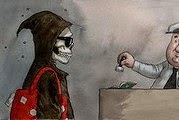Reap
what you sow with Ebola virus
The Ebola virus spreads while governments sleep on
the job.
Believe it or not, there is some good news about
the current outbreak of the Ebola virus. In spite of its fearsome reputation,
many infected patients are recovering.
You'd expect that the two American missionaries who
were flown home from Africa for special treatment would be among them. And they
were.
If the top US experts couldn't save well-funded
patients who'd been diagnosed early, nobody would be safe.
The two contracted
the virus while working to save Ebola patients in West Africa in the biggest
outbreak of the disease since it was first detected in 1976.
The Americans were
evacuated to the US in a special biosecure unit in a private jet to Emory
University Hospital.
There's no known
vaccine or cure for Ebola. But the two were given a drug still in its
experimental phase, ZMapp, described as a cocktail of antibodies, as a
desperate measure.
"Today is a
miraculous day," declared Kent Brantly, a 33-year-old doctor from Texas
when he was pronounced cured.
So was it a triumph
for the experimental drug? "The honest answer is we have no idea,"
said the medical director of the infectious disease unit at the hospital, Bruce
Ribner.
The drug itself seems
not to be a miracle. ZMapp was also given to a Spanish priest with the disease.
He too was evacuated, and treated in Europe. Yet he died.
The more remarkable
side of the story is that ordinary Africans in ordinary African clinics are
also surviving. Patients who have not been given any experimental drugs, just
basic medical care.
Not all are
surviving. But, so far in this outbreak, 47 per cent of people infected with
Ebola have recovered, according to the World Health Organisation.
And this is a higher
survival rate than in most previous outbreaks. This is the 25th time the
virus has occurred since it was first discovered in a pair of simultaneous
instances in Africa, one near the Ebola River in the Democratic Republic of
Congo and the other in a remote district of Sudan. It's not known but is suspected
of originating in fruit bats.
Of the previous 24
outbreaks, four affected just one person. Excluding these isolated cases, the
average survival rate in past Ebola eruptions was 37 per cent, and has been as
low as just 10 per cent.
That is, the death
rate has been as high as 90 per cent. For other notorious diseases such as
typhoid or smallpox the fatality rate is 1 per cent or less.
The past ferocity of
Ebola accounts for its dread reputation in Africa. And Hollywood has done the
rest of the fearmongering for Ebola.
So when, for example,
Victoria Yillah was pronounced cured of Ebola two months ago in Sierra Leone,
it was considered miraculous. As the pregnant woman in her 30s was being
interviewed on radio about her recovery, locals gathered around loudspeakers in
the capital and hailed her as "miracle woman of the year."
And when Saa Sabas,
an agronomist in Guinea, recovered, his village refused to believe. His clinic
tested him three times to be sure, issued him a certificate of discharge, and
sent staff to assure his local community that he was recovered and not
infectious: "Despite this," Sabas told CNN, "I was
stigmatised."
The sheer fear of the
disease is one of the biggest problems in beating it. The WHO said this month
that this outbreak had been "vastly" underestimated.
The WHO on August 22
set out several ways that fear has concealed the true scope of the epidemic.
Because of fear of stigma, African families often hide their sick rather than
take them for treatment.
And even when they
seek help, they may find that frightened staff have fled: "Many treatment
centres and general clinics have closed."
"An additional
problem is the existence of numerous 'shadow-zones,'" said the WHO.
"These are villages with rumours of cases and deaths, with a strong
suspicion of Ebola as the cause, that cannot be investigated because of
community resistance or lack of adequate staff and vehicles."
After fear, the
biggest contributor to the spread of the disease has been complacency. From
media reporting you'd have the impression that this eruption began a couple of
months ago. But it actually started last December and its known reach has been
accelerating.
An estimated 2615
people in West Africa have been infected, of whom 1427 have died.
Then, on the weekend,
the first cases were confirmed outside West Africa, in the Democratic Republic
of Congo. But this strain of the disease seems to be a different one, according
to the country's health minister, Felix Numby.
So far neither strain
is known to have left Africa. But globalisation is a two-way flow of risks and
rewards. Terrorists can catch planes. So can people carrying Ebola.
In Australia,
authorities say risk of Ebola arriving is very low. Frontline staff at airports
have been told to question all people arriving from West Africa and to look for
symptoms, which include fever, vomiting and diarrhoea. There is no thermal or
other automatic scanning to detect the ill.
The Australian
government last week added $1 million to its funding of the WHO to help manage
Ebola. The Economist magazine makes a strong case for more active
management of the disease, comparing it to HIV-AIDS:
"Both were new
diseases that came out of African jungles. Both took hold in countries without
decent health infrastructure. Had AIDS been spotted in 1959" when it was
first found but not yet comprehended, it argues, 39 million lives might have
been saved.
"The story of
AIDS argues for tackling such potential plagues early." Fear is
counterproductive. Vigilance is priceless.
Peter Hartcher is the Sydney Morning
Herald international editor.Illustration by John
Shakespeare.

No comments:
Post a Comment